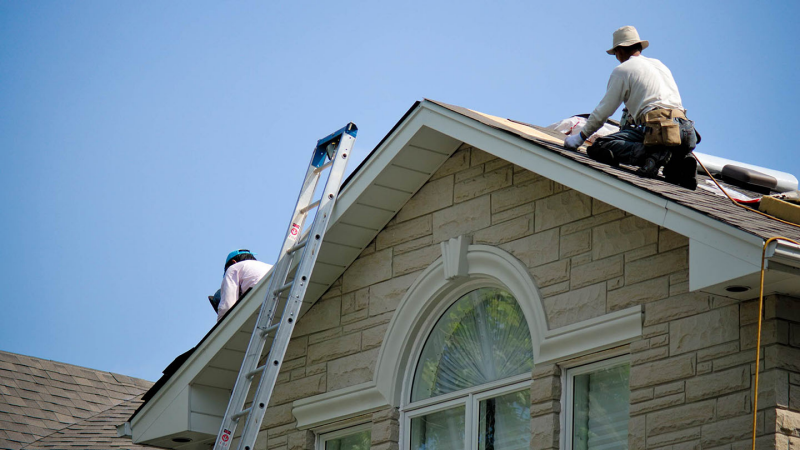How do home improvement loans work?

In some circumstances, homeownership may seem like a costly affair, with property owners possibly needing financial assistance for home renovations or repairs. That aid may come in the form of a home improvement loan. Let's explore how home improvement loans work and some common ways to finance various property upgrades.
What is a home improvement loan?
A home improvement loan is created to help homeowners finance renovations, repairs and home upgrades. It can cover projects such as roof replacement, bathroom or kitchen upgrades, home additions, energy-efficiency improvements or emergency repairs.
Generally, there isn't one dedicated "home improvement loan" that lenders may offer. Instead, borrowers could possibly use a few different types of loans for home renovations, such as a home equity loan or cash-out refinance options.
3 types of home improvement loans
Homeowners may have a few options to finance their repairs and renovations. Let's discuss some of the common home improvement loans and how they work.
1. Personal loan
A personal loan can be used to cover almost any type of expense (although some lenders might limit the ways a borrower may use it). Such flexibility is one benefit of personal loans, alongside a wide range of options to choose from and a relatively quick time to secure a loan.
While other loan types may require a form of collateral, personal loans typically don’t come with that requirement. However, this factor makes it riskier for the lenders, so it could possibly lead to higher interest rates in comparison to other home improvement loan types. Note that JP Morgan Chase does not offer personal loans.
2. Home equity loan
A home equity loan is another way homeowners may be able to finance renovations. It may look somewhat similar to a second mortgage — a borrower receives money in one sum and repays the loan at a fixed interest rate for an established period. What's more, the interest paid on a home equity loan may be tax-deductible in some situations. Chase does not offer Home Equity Loans nor Home Equity Lines of Credit (HELOC) at this time. Visit our HELOC page for future updates.
A home equity loan uses the house as collateral, so it's generally more likely to be favored among homeowners who have built significant equity over time. Typically, many lenders are likely to offer up to 80% of the equity for a home equity loan. For the same reason, this loan may carry more risk for borrowers as failing to pay the loan could potentially lead to foreclosure.
3. Cash-out refinance
A cash-out refinance might resemble a home equity loan: It also allows homeowners to tap into the home equity they built before. However, it has a different mechanism, where borrowers can access funds by replacing a mortgage with a new, larger one and receive additional cash (which can be used for home improvement projects). A cash-out refinance could also come with lower interest rates than personal or home equity loans. Yet, it might have drawbacks for borrowers, such as a requirement to pay closing costs and using the house as collateral. JPMorgan Chase does not offer tax advice. Please consult your tax advisor regarding the deductibility of interest for home improvements.
Important Notice to Servicemembers and Their Dependents: A refinance may not be advantageous to you if you are currently eligible for benefits provided by the Servicemembers Civil Relief Act (SCRA). If you are an SCRA-eligible customer and have questions about the SCRA or about refinancing, please discuss with your Home Lending Advisor. The amount you save on a refinanced mortgage may vary by loan. If a refinanced mortgage has a longer term than remains on your current loan, you will incur additional interest charges for the extended term.
How to choose a home improvement loan
Different home improvement loans may be more suitable for particular projects or situations. Here are some factors to remember when choosing a home renovation loan.
- The size of the loan: This aspect may be one of the key considerations when choosing a home improvement loan. A personal loan might typically offer more flexibility and be a viable option for repairs of any scope. On the other hand, loans like cash-out refinances may come with additional expenses, such as closing costs, and take longer to process. For these reasons, it could be more practical to use them for larger projects.
- Existent home equity: If homeowners lived in the house for a long time and were able to build significant equity, it could be helpful to look into a cash-out refinance or home equity loans. An FHA 203(k) loan was created for homebuyers of distressed properties to finance repairs right after purchase and does not require any home equity. Note that JPMorgan Chase does not offer FHA 203(k) loans.
- Time considerations: Not every loan may work depending on the timeline and urgency of the situation. For example, since cash-out refinances and home equity loans typically take longer to get approved, they might not be ideal for emergency repairs.
Pros and cons of home improvement loans
A home renovation loan could possibly be a good way to finance the necessary repairs or home upgrades, yet it might have some drawbacks as well. Here are some pros and cons of home improvement loans to consider:
Advantages of home improvement loans
- Different options to choose from, suitable for many types of lenders.
- Possibility to finance large improvement projects fairly quickly.
- May be available for various types of projects and renovations.
Disadvantages of home improvement loans
- Depending on the type, they may require tapping into home equity.
- Possibly high interest rates and additional fees, such as closing costs.
- Some loans may require using a house or other assets as collateral.
In summary
Generally, home renovation loans may be used for renovations and upgrades of any scale, from buying new furniture to building a home addition. The various types of home improvement loans may work differently, so it may help to take some time, shop around and talk to a professional to choose the one that's most suitable for a particular situation and your needs.
How do home improvement loans work? FAQs
1. Are home improvement loans tax deductible?
The answer depends on the exact type of loan used for the home improvement project. For example, the IRS may allow a deduction on the interest paid on home equity loans. However, the loan has to be used specifically to "buy, build, or substantially improve your home."3 It may be best to consult a professional who could assess your situation and give advice based on more information.
2. Can you use a home loan for renovations?
Yes, it may be possible to use a home loan for renovations. You can apply for a home loan from a lender and if approved, you’ll receive the money as a lump sum.
3. Can you use a home improvement loan for anything?
Homeowners may be able to use home improvement loans for a variety of renovation projects, such as kitchen or bathroom remodeling, roof repairs, building an addition (bedroom, dining room, etc.) or buying new furniture. However, some loans may come with certain regulations from lenders that are important to comply with.



